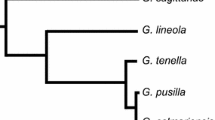Abstract
AdultC. montrouzieri were able to detect their prey by visual and chemical stimuli. Presence of mealybug caused a significant increase in the number of turns and a sharp decrease in flight attempts suggesting detection by olfaction. In the light, adult predators found polystyrene dummies significantly faster than under dark (red light) conditions, but light had no effect on the time taken for adults to pass across an invisible test point. Fourth instar larvae could only perceive the prey by physical contact.
Résumé
Les adultes deC. montrouzieri sont capables de détecter leur proie grâce à des stimuli visuels ou/et olfactifs. La présence de la cochenille se traduit par une augmentation significative du nombre de changements de direction et par une diminution importante des tentatives d'envol. Ces observations suggèrent l'existence d'une détection de la proie par olfaction. A la lumière, les adultes de ce prédateur trouvent plus rapidement des leurres en polystyrène qu'ils ne le font à l'obscurité (lumière rouge). Mais la lumière est sans effet sur le temps mis par les adultes pour traverser un point test invisible. Les larves de quatrième stade percevrait la proie uniquement par contact physique.
Similar content being viewed by others
References
Allen, C. D., Knight, F. B. &Foltz, J. H. — 1970. Invertebrate predators of the Jack-pine budwormChoristoneura pinus in Michigan.Ann. Entomol. Soc. Am., 63, 59–64.
Banks, C. J. — 1954. The searching behaviour of Coccinellid larvae.Br. J. Anim. Behav., 2, 37–38.
Banks, C. J. — 1956. Observation on the behaviour and mortality in Coccinellidae before dispersal from the egg shell.Proc. R. ent. Soc. Lond. (A), 31, 4–6.
Banks, C. J. — 1957. The behaviour of individual Coccinellid larvae on plants.Br. J. Anim. Behav., 5, 12–24.
Cochran, W. G. &Cox, G. M. — 1957. Experimental design, 2nd edition, Wiley, N. York, 611 p.
De Bach, P. — 1974. Biological control by natural enemies,Cambridge University Press, London, 323 p.
Fleschner, C. A. — 1950. Studies on searching capacity of the larvae of the three predators of the citrus mite.Hilgardia, 20, 233–265.
Hagvar, E. B. &Hofsvang, T. — 1987. Foraging by the aphid parasitoidEphedrus cerasicola for patchily distributed hosts.Entomol. exp. appl., 44, 81–88.
Hulspas-Jordan, P. M. &Van Lenteren, J. C. — 1978. The relationship between host-plant leaf structure and parasitization efficiency of the parasitic waspEncarsia formosa Gahan (Hym: Aphelinidae).Med. Fac. Landbouww. Rijksuniv. Gent., 43, 432–440.
Kehat, M. — 1968. The feeding behaviour ofPharoscymnus numidicus (Col.: Coccinellidae). A predator of date palm scale,Parlatoria blanchardi. Entomol. exp. appl., 11, 30–42.
Keller, M. A. — 1987. Influence of leaf surface on movement by hymenopterous parasitoidsTrichogramma exiguum.Entomol. exp. appl., 43, 55–59.
Marks, R. J. — 1977. Laboratory studies of plant searching behaviour byCoccinella septempunctata L. larvae.Bull. Entomol. Res., 67, 235–241.
Murakami, Y. &Tsubaki, Y. — 1984. Searching efficiency of the lady beetleCoccinella septempunctata larvae in uniform and patchy environments.J. Ethol., 2, 1–6.
Nakamuta, K. — 1984. Visual orientation of the ladybeetleCoccinella septempunctata L. (Col: Coccinellidae), caused by prey consumption.Appl. Entomol. Zool., 17, 501–506.
Obata, S. — 1986. Mechanisms of prey finding in the aphidophagous ladybird beetleHarmonia axyridis (Coleoptera: Coccinellidae).Entomophaga, 31, 303–311.
Storch, R. H. — 1976. Prey detection by fourth stageCoccinella transversoguttata larvae (Col: Coccinellidae).Anim. Behav., 24, 690–693.
Stubbs, M. — 1980. Another look at prey detection by Coccinellids.Ecol. Entomol., 5, 179–182.
Vinson, S. B. — 1976. Host selection by insect parasitoids.Ann. Rev. Entomol., 21, 109–123.
Waage, J. K. — 1978. Arrestment reponses of parasitoidNemeritis canescens to a contact chemical produced by its hostPlodia interpunctella.Physiol. Entomol., 3, 135–146.
Waage, J. K. — 1983. Aggregation in field populations: foraging time allocation by a population ofDiadegma, (Hym: Ichneumonidae).Ecol. Entomol., 8, 447–453.
Author information
Authors and Affiliations
Rights and permissions
About this article
Cite this article
Heidari, M., Copland, M.J.W. Host finding byCryptolaemus montrouzieri (Col., Coccinellidae) a predator of mealybusgs (Hom., Pseudococcidae). Entomophaga 37, 621–625 (1992). https://doi.org/10.1007/BF02372333
Received:
Accepted:
Issue Date:
DOI: https://doi.org/10.1007/BF02372333




